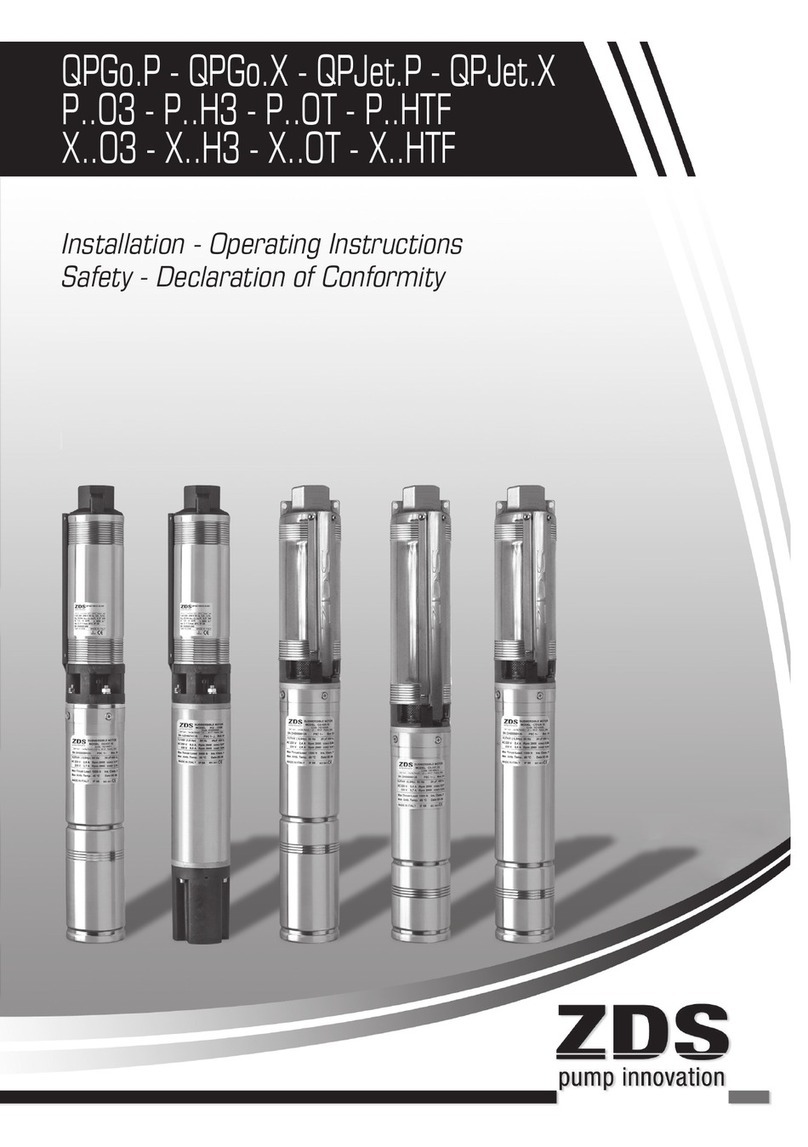
GB
D
F
I
E
PL
HR
MNE
RO
SRB
8
1- STORAGE AND HANDLING
Storage temperature: -15°C to +50°C. The non-packaged pump must be stored according to the diagram
in Fig.1 to prevent possible misalignment. The pump must not be exposed to direct sunlight.
Any operation required on the pump must be carried out by qualified personnel after
disconnection from the mains.
If the pump is not used in a vertical position, it must be handled with care and using the appropriate lifting
equipment in order to prevent damage (fig. 2).
2- USER
The submersible pumps for 4” wells offer a wide range of flow rates and heads making them ideal for water
raising, pressurisation and distribution in civil and industrial systems, for supplying autoclaves and tanks,
for fire-fighting and cleaning, for hobbies and for irrigation systems.
The pumps are designed to pump clean water, without solid particles or fibres, and not explosive liquids.
The maximum quantity of sand tolerated is 120 g/m3.
The metal and plastic components of the pumps are of the approved type for use with alimentary liquids.
3- CONNECTION OF THE PUMP TO A SUBMERSIBLE MOTOR FOR 4” UNASSEMBLED PUMPS
The pump can be coupled with a 4” submersible motor in compliance with NEMA regulations.
For correct assembly, proceed as follows (fig. 3):
a)
Remove the cable cover (1) from the outer jacket of the pump (7) by unscrewing the fastening screws (2).
b) Ensure that the shaft, the joint and the coupling surfaces are clean.
c) Position the motor (3) vertically.
d) Connect the pump to the motor, aligning the “grommet” aperture of the lower support with the motor
cable output.
e) Tighten the nuts (4) on the tie rods (5), fixing the pump to the motor in a diagonal sequence with a
tightening torque of 16-20 Nm (inox) / 11-12 Nm (tecnopolymer).
f) Lay the motor cable (6) along the outer jacket (7), cover it with the cable cover (1) and secure it by
means of the screws (2).
4- OPERATING LIMITS
Maximum temperature of the pumped liquid: 40°C (O2-O3-OT), 30°C (H2-H3-HTF) • Maximum depth below
water level: 150 m (O2-O3-OT), 350 m (H2-H3-HTF) • Maximum number of starts per hour: 150 • Pro-
tection: IP 68 • Installation: for correct motor operation must be guaranteed a flow of water around the
motor casing of at least 8 cm/s • For use of the pump in swimming pools and garden pools, compliance
with the CEI 61-69 (EN 60335-2-41) standard must be guaranteed.
5- INSTALLING THE PUMP (Fig. 4)
The pump is designed to operate in a vertical or horizontal position.
You are recommended to fit a non-return valve on the delivery line to prevent water hammering; be careful
not to damage the supply cable when lowering it into the well and fasten it to the delivery pipe at intervals
of approximately 3 m.
5.a- Installation in the well
The pump can be lowered into wells with a diameter of 4” or larger. Ensure that the motor does not rest
on the bottom of the well and that the pump is fully submerged in the water.
Protect the pump from running dry by means of level probes if there is the danger of lowering of the water bed.
Dry operation will seriously damage the pump.
Never test the pump out of the water.
5.b- Installation in collecting tank or reservoir
To prevent damage, the tank or reservoir must be sized to avoid more than 150 pump starts per hour.
5.c- Suspension cord
You are advised always to use a steel or nylon suspension cord




























